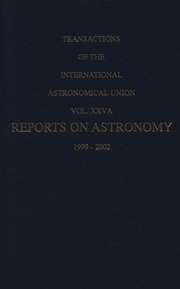No CrossRef data available.
Article contents
41. History of Astronomy (Histoire De L’astronomie)
Published online by Cambridge University Press: 24 November 2021
Extract
Commission 41 has been involved in one colloquium and one symposium since the last report:
IAU Colloquium 91 on “The History of Oriental Astronomy” was held in New Delhi, November 13-16, 1985, preceding the XlXth General Assembly. Members of the scientific organizing committee were S.M.R. Ansari, E.S. Kennedy, D. King, R. Mercier, O. Pedersen, D. Pingree, G. Saliba, Xi Ze-Zong and K. Yabuuti. The colloquium was co-sponsored by the International Union for the History and Philosophy of Science, and by a number of organizations in India: the Council of Scientific and Industrial Research, New Delhi, the Department of Science and Technology, New Delhi, the Indian Institute of Astrophysics, Bangalore, the Indian National Science Academy, New Delhi, the Tata Institute of Fundamental Research, Bombay, and the University Grants Commission, New Delhi. The local organizing committee, chaired by G. Swarup, made possible a number of local excursions, including a conducted tour of the great stone open air observatory, built in the city by the enlightened Maharadjah Jai Singh in the 18th century. The colloquium brought 84 participants from 19 countries. 46 papers were presented of which 10 were invited, covering aspects of astronomy in the far east and middle east since the earliest civilizations. Papers from Colloquium 91 have now been published in book form: History of Oriental Astronomy, G. Swarup, A.K. Bag, and K.S. Shukla, editors, Cambridge University Press, Cambridge, England, 1987. Contributions are divided into three broad categories: ancient astronomy and its characteristics, ancient elements and planetary models, and medieval astronomy. Within these are papers on the characteristics and achievements of early astronomy in the eastern half of the world, including inter-regional development and mutual influences, ancient data relating to eclipses, supernovae and comets, medieval astronomical developments, instruments and early observatories, and the interplay between observational and theoretical astronomy. A short introductory paper by the revered historian E.S. Kennedy opens the book, as it set the stage for the colloquium in New Delhi: “We find (astronomy) originating a few centuries before the Christian era in two disparate cultures, Mesopotamia and the Hellenistic world. From the Mediterranean it passed to India, there to flourish. Thence the centroid of activity moved westward, residing in the lands of Islam during medieval times, more recently in Europe. Now astronomical research is carried out throughout the entire world.”
- Type
- Research Article
- Information
- Copyright
- Copyright © Kluwer 1988


